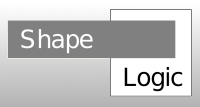
ShapeLogic has a declarative goal driven logic engine.
The syntax of the logic language is better described in Logic language.
E.g. the context makes it possible to have the string "Letter" bound to both "A" and "B" at the same time in difference context. When matching a letter it will have a context for A and one for B, eventually one will be chosen, and the other discarded. The context is set up a hierarchically, like in most programming languages, so that names bound in a higher context can be seen in a lower one. So the string polygon is set at the root context level and can be seen by all the other context.
This relies on Java Expression Language (JEXL)
ShapeLogic is driven by a tree of task, the super class is called BaseTask.
A task can have sub tasks, but also have a context that inherits from the context of the parent task. Not all tasks have their own context.
For examples of simple rules and task hierarchy look in the classes
At the top level of the tree there is an Exclusive or task, XOrTask. Underneath is an AndTask for each letter. For each AndTask there are several simple property rules, of type ParametricRuleTask
Each AndTask has its own context that values can be set in, but all the SimpleTasks under an AndTask share a context. When a letter is finally chosen then the context from the chosen context is propagated up.
The vectorizer will put a MultiLinePolygon object into the string "polygon" in a JEXL context.
Then there are rules that go in and look at the object using reflection. Here is an example of a simple NumericRule:
NumericRule("A", "pointCount", "polygon.getPoints().size()", 5.),Here is an example of all the rules for a letter:
NumericRule[] numericRulesForA = {
new NumericRule("A", POINT_COUNT, POINT_COUNT_EX, 5.),
new NumericRule("A", LINE_COUNT, LINE_COUNT_EX, 5.),
new NumericRule("A", HORIZONTAL_LINE_COUNT, HORIZONTAL_LINE_COUNT_EX, 1.),
new NumericRule("A", VERTICAL_LINE_COUNT, VERTICAL_LINE_COUNT_EX, 0.),
new NumericRule("A", END_POINT_COUNT, END_POINT_COUNT_EX, 2.),where
POINT_COUNT = "pointCount"; POINT_COUNT_EX = "polygon.getPoints().size()"
All these rules are combined into an AndTask. A whole letter match will then be an XOrTask with an AndTask for each letter.
If you need to do more complex boolean combinations of filter on polygons try the following:
"polygon.filter('PointRightOfFilter(0.3) && PointAboveFilter(0.3)')"
"polygon.filter('PointOfTypeFilter(PointType.T_JUNCTION) && PointLeftOfFilter(0.5)').size()"Currently ShapeLogic is using the standard Java, C, C++ notation:
And use && Or use || Not use !
Prolog was all the rage in the early 1980s, the Japanese 5 generation project was mainly based on Prolog. It turned out that it did not scale well to real world problems, partly because it was only good at handling symbolic information and not doing computations, and Prolog fell out of favor.
Despite this, I still think programming in Prolog is almost as simple as SQL.
ShapeLogic is trying to preserve this simplicity of Prolog, while maintaining ability to do efficient numerical calculations.
ShapeLogic is not using backtracking or unification, 2 of the main components in Prolog, but shares the idea of programming as goals and tasks with sub goals or horn clauses
Unlike Prolog, ShapeLogic can have multiple values for a name at the same time, and can explore different choices at the same time.
Oz is an experimental language boasting:
ShapeLogic merges contexts when faced with different options in a similar way to Oz, though this is not fully implemented yet.